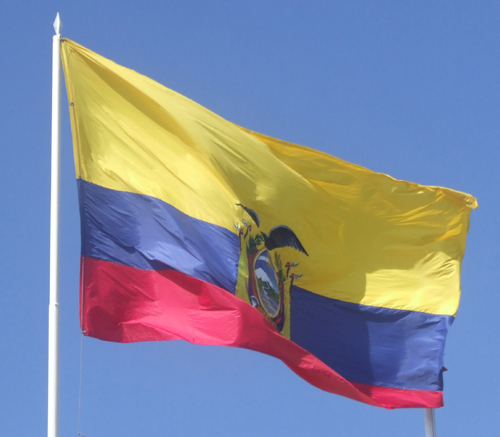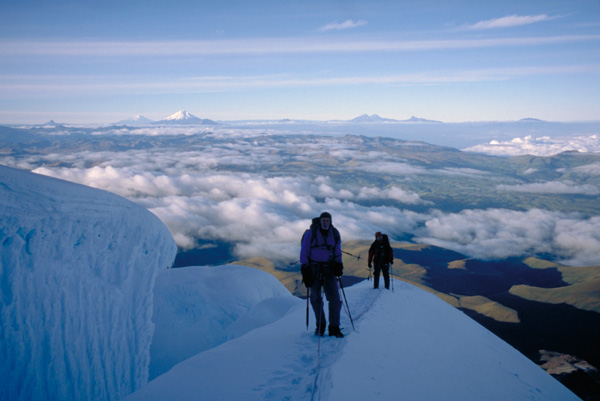Ecuador and the Galapagos

Ecuador is one of the smallest South American countries and is particularly famous for two natural wonders. The Avenue of the Volcanoes has been well known to mountaineers around the world since the British mountaineer Whymper first travelled and climbed here at the end of the 19th century. The Galapagos Islands have been famous since Charles Darwin arrived on the Beagle in 1835. It was here, through observing the islands rich bird-life, that he formulated his theories on natural selection and evolution.
The best base for all the activities described here is in or near the capital city of Quito. From here most walks and treks can be reached in a short drive or bus journey and you can fly directly to the Galapagos islands.
The Avenue of the Volcanoes
The capital city Quito and many of Ecuador's other cities lie in a long Andean valley between two chains of volcanoes known as the 'Avenue of the Volcanoes'. There are some very good highland treks here and the volcanoes are easy or interesting ascents.

Rooftops and the Plaza San Francisco in Quito
The most famous trek is probably the Inca Trail to Ingapirca. This is a worthwhile trek in its own right but should not be confused with the original and better Inca Trail near Cuzco in Peru. The Ecuador version is a 2-3 day trek over Andean moorlands at about 4000m which starts in Achupallas near the town of Alausi and passes several small ruins before reaching one of Ecuador's best Inca ruins at Ingapirca. Two other popular treks are the four day Antisana to Cotopaxi hike and the trek around Cotopaxi. Although not a complete circuit this three day walk gives some splendid views of Cotopaxi volcano and also gets you to some of the least visited areas of the Cotopaxi national park.
Of the volcanoes the easiest ascent and the only climb suitable for those with little mountaineering knowledge is Tungurahua 5023m which rises above the jungle town of Baños near Ambato. However in recent years it has been off-limits due to volcanic activity. The climb takes two days and there used to be a small hut at 3800m. The area around Baños is also excellent for shorter day walks and other adventure activities like rafting.

Climbing on Volcan Cayamabe
Ecuador's most famous volcano is Cotopaxi 5897m. This makes a marvellous ascent with a great view into the deep crater but it is definitely only for those with a guide or with previous mountaineering experience as there are some very large and potentially dangerous crevasses. The trip to the summit takes three days from Quito, where mountain guides and transport to the hut on the north slopes can be arranged. Other popular peaks are the countries highest Chimborazo and the peak of Cayambe on the equator. Both are usually slightly harder climbs than Cotopaxi, although this can vary from year to year. Unfortunately the weather on all three summits, as on all peaks in Ecuador, can be a bit unpredictable.
For easier walking in beautiful scenery try the Cajas National Recreation Area close to the pretty city of Cuenca in the south of the country. This is an area of wild moorland 'paramo' dotted with numerous small lochs.
Mountain biking has become very popular in recent years. It is not surprising that most people want to bike downhill, often starting in the mountains near Quito and finishing in one of the lowland rainforest areas. One notable ride is from Zumbahua to Sigchos, taking several days and passing the crater lake at Quilotoa. Another good trip takes you round the south of Ecuador's highest peak Chimborazo, from the village of Pogyos to the town of Riobamba in about three days. There are lots more possibilities and there are an increasing number of tour agencies in Quito offering bike tours.
Rafting has also become popular in Ecuador and is a very suitable activity for the wet climate. The Rio Blanco and Rio Upano are two of the most frequently descended. Jungle river trips are also popular in Ecuador's small portion of the Amazon rainforest with easy access from the areas around Baños and Misahualli. All these trips can be organised with local outfitters in Quito and are easily combined with a trekking or climbing holiday.
The Galapagos Islands
These spectacular volcanic islands lie in the Pacific Ocean, 1000km west of the Ecuadorian coast. They offer a unique opportunity to see a great variety of wildlife, including giant tortoises, sea lions, flamingos, iguanas and penguins. They particularly appeal to bird watchers who come to see the huge variety of finches made famous by Darwin. Much of the wildlife is incredibly tame because the islands were uninhabited for a long time and there were no natural predators. These dry islands also have spectacular scenery and a number of the volcanoes are still active. There are good day walks on most islands and good diving offshore.
The most common, and probably the best way to see the islands is to go on an organised boat tour. This can be arranged in advance from the UK or you can go with one of many agencies in Ecuador. Puerto Ayora on Santa Cruz island is the main tourist centre in the islands and a good place to join a boat tour if you're arriving in the islands with nothing arranged. These boat trips will all include some shore trips and may include some diving as well. Specialised diving trips, for beginners as well as experienced divers can also be organised in the town of Puerto Ayora.
Ecuador Factfile
When to go - Ecuador is best in June-August or December-January. The Galapagos are best in December-May.
Weather - Mixed but fairly wet all year round. The Galapagos are very dry.
Flights - From London to Quito via Madrid, Amsterdam, Bogota or Miami, from £800. To reach the Galapagos fly from Quito for an extra US$600-800
Guidebooks - 'The Andes - A Guide for Climbers
and Skiers' by John Biggar,
the the guy who wrote this website gives details of the volcano ascents
mentioned. The
Lonely Planet 'Ecuador and the Galapagos' guide has a good wildlife section on
the Galapagos. Many specialist natural history books are also available on the
Galapagos.

